
The South Bruny National Park is a national park located on Bruny Island, Tasmania, Australia, about 50 kilometres (31 mi) south of Hobart. The park contains the Cape Bruny Lighthouse. The highest point of the park is Mount Bruny at 504 metres (1,654 ft).

Kangaroo Island, also known as Karta Pintingga, is Australia's third-largest island, after Tasmania and Melville Island. It lies in the state of South Australia, 112 km (70 mi) southwest of Adelaide. Its closest point to the mainland is Snapper Point in Backstairs Passage, which is 13.5 km (8.4 mi) from the Fleurieu Peninsula.
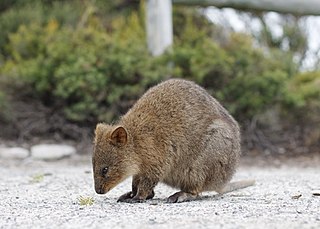
The quokka is a small macropod about the size of a domestic cat. It is the only member of the genus Setonix. Like other marsupials in the macropod family, the quokka is herbivorous and mainly nocturnal.

The bridled nail-tail wallaby, also known as the bridled nail-tailed wallaby, bridled nailtail wallaby, bridled wallaby, merrin, and flashjack, is a vulnerable species of macropod. It is a small wallaby found in three isolated areas in Queensland, Australia, and whose population is declining. In early 2019 the total population of the species was estimated to be fewer than 500 mature individuals in the wild and 2285 in captivity.
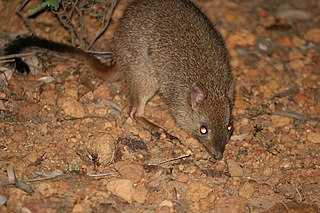
The woylie or brush-tailed bettong is a small, critically endangered mammal native to forests and shrubland of Australia. A member of the rat-kangaroo family (Potoroidae), it moves by hopping and is active at night, digging for fungi to eat. It is also a marsupial and carries its young in a pouch. Once widespread, the woylie mostly died out from habitat loss and introduced predators such as foxes. It is currently restricted to two small areas in Western Australia. There were two subspecies: B. p. ogilbyi in the west, and the now-extinct B. p. penicillata in the southeast.
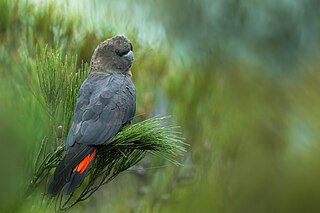
The glossy black cockatoo, is the smallest member of the subfamily Calyptorhynchinae found in eastern Australia. Adult glossy black cockatoos may reach 50 cm (19.5 in) in length. They are sexually dimorphic. Males are blackish brown, except for their prominent sub-terminal red tail bands; the females are dark brownish with idiosyncratic yellow marking around the neck and prominent sub-terminal tail band of red with black bars. Three subspecies have been recognised, although this has been recently challenged, with a detailed morphological analysis by Saunders and Pickup 2023 finding there is cline in body dimensions over the latitudinal range of the species, with the birds from the north of the range smaller than the birds in the south. Saunders and Pickup argued that with no differentiation in bill morphology, little difference in genetic makeup, no differences in plumage pattern or colour, and no differences in diet, there is no justification in subdividing the species.

The yellow-footed rock-wallaby, formerly known as the ring-tailed rock-wallaby, is a member of the macropod family.

The Kangaroo Island dunnart is a dark sooty-grey coloured dunnart species first described in 1969, with paler underparts of its body. It has an average body length of 170–198 mm, a snout to anus length of 80–93 mm, a tail measurement of 90–105 mm, a hind foot of 17.5 mm, ear length of 18 mm and a weight of 20–25 grams. The thin tail is also gray, but lighter on the bottom. The tail is longer than the body. Kangaroo Island dunnarts are dimorphic, with males larger than females.
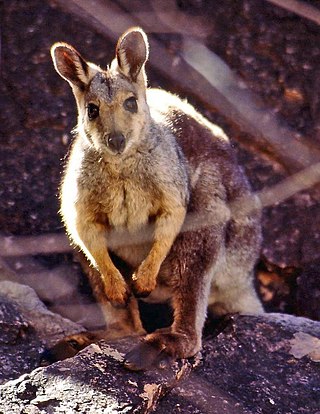
The black-flanked rock-wallaby, also known as the black-footed rock-wallaby or warru, is a species of wallaby, one of several rock-wallabies in the genus Petrogale. A shy, nocturnal herbivore, its two main subspecies are found in mostly isolated populations across western and southern Western Australia (WA), the Northern Territory and parts of South Australia (SA). With some subspecies showing a decline in populations in recent years, the whole species is classed as an endangered species under the Commonwealth EPBC Act.

The Western barred bandicoot, also known as the Shark Bay bandicoot or the Marl, is a small species of bandicoot; now extinct across most of its former range, the western barred bandicoot only survives on offshore islands and in fenced sanctuaries on the mainland.

The Australian Wildlife Conservancy (AWC) is an independent Australian nonprofit organisation, working to conserve threatened wildlife and ecosystems in Australia. AWC is the largest private owner and manager of land for conservation in Australia, currently managing 31 sanctuaries and partnership sites for wildlife conservation that cover over 6.5 million hectares of land across Australia. It partners with governmental agencies, Indigenous groups, and private landholders to manage landscapes for effective conservation. Most funding comes from private support in the form of tax-deductible donations from the public, as well as some government grants for particular purposes, such as from the Australian government's National Reserve System Program.
Buckaringa Sanctuary is a 20 km2 nature reserve in the southern Flinders Ranges of South Australia. It is 30 km north of the town of Quorn. It is owned and managed by the Australian Wildlife Conservancy (AWC).

The Ascension scrub and grasslands ecoregion covers the dormant volcano, Ascension Island in the Atlantic Ocean. As well as shrubs and grasses wildlife on the island includes a range of unique flora and fauna. In particular the surrounding islets are important havens for many seabirds. However the seabird populations on Ascension Island itself have been severely affected by introduced species, especially cats, which were the subject of an eradication campaign between 2002 and 2006.

Red foxes pose a serious conservation problem in Australia. 2012 estimates indicate that there are more than 7.2 million red foxes, with a range extending throughout most of the continental mainland. The species became established in Australia through successive introductions, by settlers, beginning around the 1830s. Due to its rapid spread and ecological impact, it has been classified as one of the most damaging invasive species in Australia.

Seabirds include some of the most threatened taxa anywhere in the world. For example, of extant albatross species, 82% are listed as threatened, endangered, or critically endangered by the International Union for Conservation of Nature. The two leading threats to seabirds are accidental bycatch by commercial fishing operations and introduced mammals on their breeding islands. Mammals are typically brought to remote islands by humans either accidentally as stowaways on ships, or deliberately for hunting, ranching, or biological control of previously introduced species. Introduced mammals have a multitude of negative effects on seabirds including direct and indirect effects. Direct effects include predation and disruption of breeding activities, and indirect effects include habitat transformation due to overgrazing and major shifts in nutrient cycling due to a halting of nutrient subsidies from seabird excrement. There are other invasive species on islands that wreak havoc on native bird populations, but mammals are by far the most commonly introduced species to islands and the most detrimental to breeding seabirds. Despite efforts to remove introduced mammals from these remote islands, invasive mammals are still present on roughly 80% of islands worldwide.

The Yathong Nature Reserve is a protected nature reserve that is also a nationally and internationally recognized biosphere situated in the central-western region of New South Wales, in eastern Australia. The 107,240-hectare (265,000-acre) reserve was listed by UNESCO in 1977 as a Biosphere Reserve under the Man and the Biosphere Programme (MAB). The reserve is significant for its biodiversity in both native plant and animal species. Cultural heritage and historical grazing activities add to the significance of this site as a conservation area.
Cats are a popular pet in New Zealand. Cat ownership is occasionally raised as a controversial conservation issue due to the predation of endangered species, such as birds and lizards, by feral cats.
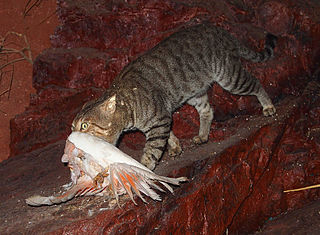
Feral cats are an invasive species in Australia. Because they are not native to Australia and were only introduced by European colonists as pets in the early 1800s, native Australian animals did not co-evolve with them. As of 2016, some 3.8 million domestic cats and up to 6.3 million feral cats continue to live in Australia.
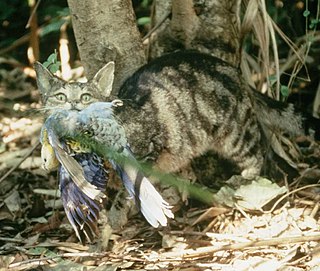
Cat predation on wildlife is the result of the natural instincts and behavior of both feral and owned house cats to hunt small prey, including wildlife. Some people view this as a desirable trait, such as in the case of barn cats and other cats kept for the intended purpose of pest control in rural settings; but scientific evidence does not support the popular use of cats to control urban rat populations, and ecologists oppose their use for this purpose because of the disproportionate harm they do to native wildlife. Recognized as both invasive species and predators, cats have been shown to cause significant ecological harm across various ecosystems.
Heirisson Prong is a community managed reserve established for the conservation of threatened mammals at Shark Bay in Western Australia. The reserve is at the point of a long narrow peninsula of the same name that juts into Shark Bay from the south.

















